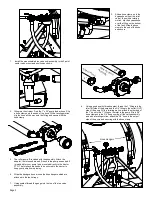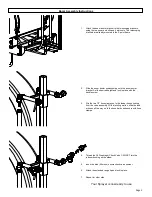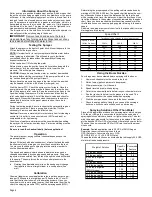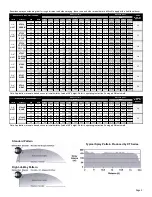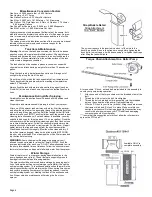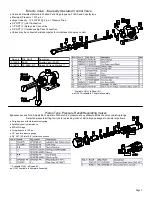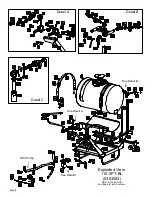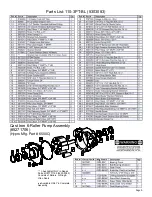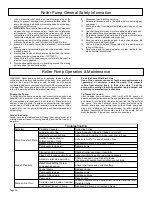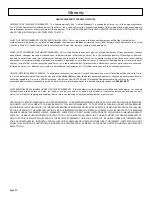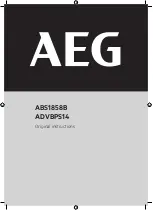
Page 6
A torque chain, ‘S’ hook, nut and bolt are included in this assembly to
secure your pump during operation.
1.
Attach one end of the torque chain over the threaded stem of the
bolt
2.
Thread the whiz nut onto the bolt. Hand-tighten
3.
Thread the bolt, chain and nut ‘pre-assembly’ into the threaded
hole on the underside of the pump. Tighten sufficiently
4.
Affix the ‘S’ Hook to your frame (or hitch). Wrap the chain around
the frame or hitch and ‘S-Hook’ it in place. Make sure this con-
nection is very secure! Not having a good, tight connection may
result in the pump spinning on your PTO shaft and damaging
some components of your sprayer
*** Insure that this connection point will not allow the roller pump to
spin on the PTO shaft ***
Torque Chain Attachment to a Roller Pump
Strap/Buckle Detail
Strap Attachment
to a “Bent” Buckle
The nylon straps are to be inserted in and out of the slots in the
buckle, as shown. Be sure the straps are snug before tightening the
hook bolts. In most cases, it will be necessary to re-tighten the straps
after filling the tank with liquid.
Miscellaneous Conversion Factors
One Acre = 43,560 square feet = 0.405 Hectare
One Hectare = 2.471 Acres
One Gallon Per Acre = 9.35 Liters Per Hectare
One Mile = 5,280 Feet = 1,610 Meters = 1.61 Kilometers
One Gallon = 128 Fluid Ounces = 8 Pints = 4 Quarts = 3.79 Liters =
0.83 Imperial Gallons
One Pound Per Square Inch = 0.069 bar. = 6.895 Kilopascals
One Mile Per Hour = 1.609 Kilometers Per Hour
Higher pressure not only increases the flow rate of the nozzle, but it
also influences the droplet size and the rate of orifice wear. As pres-
sure is increased, the droplet size decreases and the rate of orifice
wear is increased.
The values given in the tabulation section of this your owners manual
indicates the most commonly used pressure ranges for the
associated spray tips.
Tank Care & Maintenance
Warning:
Do not use the tank as a container for fuel oils, kerosene,
gasoline or any other petroleum distillate product. All polyolefins are
softened and permeated by such products. In an enclosed area the
vaporization of these materials from the outside surface of the tank
could create a dangerous condition.
The tank should not be used as a pressure vessel nor used with
chemicals or solutions having a weight of more than 12 pounds per
gallon.
Store the tank in a dry dark place when not in use. Storage out of
sunlight will prolong the life of the tank.
Do not drop, strike or kick the tank, especially at low temperatures.
Tanks become brittle and are subject to cracking at temperatures
below 20° Fahrenheit.
Always flush the tank with water and a neutralizing agent (such as
‘Nutra-Sol’) at the end of each use, to prevent contamination of solu-
tions.
Maintenance During/After Spraying
Periodically close the suction line valve and check the strainer and
clean the screen.
Proper care and maintenance will prolong the life of your sprayer.
After use, fill the sprayer tank part way with water. Start the sprayer
and allow the clear water to be pumped through the plumbing system
and out through the spray nozzles. Refill the tank about half full with
plain water and use FIMCO Tank Neutralizer and Cleaner and repeat
cleaning instructions above (If no tank cleaner is available, you may
substitute dish soap for this step, about 1-2 oz. per gallon). Flush the
entire sprayer with the neutralizing/cleaning agent, then flush out one
more time with plain water. Follow the chemical manufacturer’s dis-
posal instructions of all wash or rinsing water. For the boom (if appli-
cable) remove the tips and screens from the nozzle assemblies.
Wash these items out thoroughly. Blow the orifice clean and dry. If
the orifice remains clogged, clean it with a fine bristle (NOT WIRE)
brush or with a toothpick. Do not damage the orifice. Water rinse and
dry the tips before storing.
WARNING:
Some chemicals will damage the pump valves if
allowed to soak untreated for a length of time! ALWAYS flush the
pump as instructed after each use. DO NOT allow chemicals to sit in
the pump for extended times of idleness. Follow the chemical manu-
facturer’s instructions on disposal of all waste water from the sprayer.
Winter Storage
Drain all water out of your sprayer, paying special attention to the
pump, handgun and valve(s). These items are especially prone to
damage from chemicals and freezing weather.
The sprayer should be winterized before storage by pumping a solu-
tion of automotive antifreeze (containing a rust inhibitor) through the
entire plumbing system. This antifreeze solution should remain in the
plumbing system during the winter months. When spring time comes
and you are preparing your sprayer for the spray season, rinse the
entire plumbing system out, clearing the lines of the antifreeze solu-
tion. Proper care and maintenance will prolong the life of your
sprayer.
Available ONLY in
complete assembly


